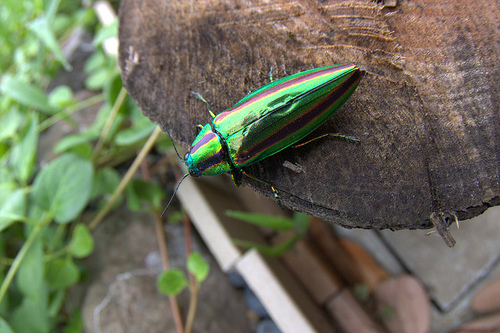Iridescent beetles, jet-propelled nautiluses and “walking cactus”
 The secret to the Japanese jewel beetle’s shine is layers of chitin, threats to the ancient nautilus, a “walking cactus” provides a link between worm and insect, researchers propose drying out Australia’s cane toads, macaques display awareness of their own uncertainty and Florida’s alligator mating season is close at hand. Here is research in ecology and beyond from the last week in February.
The secret to the Japanese jewel beetle’s shine is layers of chitin, threats to the ancient nautilus, a “walking cactus” provides a link between worm and insect, researchers propose drying out Australia’s cane toads, macaques display awareness of their own uncertainty and Florida’s alligator mating season is close at hand. Here is research in ecology and beyond from the last week in February.
Iridescent beetle: A study recently published in The Philosophical Transactions of the Royal Society Biological Sciences explored the stacked chitin layers on the body and wings of the Japanese jewel beetle (Chrysochroa fulgidissima). Danielle Venton described the beetle in a Wired Science article: “[S]urface ridges cause visible iridescence, but their primary job is to deflect water or mud. Many are active at night, when their colors can’t be seen. But the Japanese jewel beetle’s surface is smooth, and the study’s authors suspect that iridescence helps these insects recognize each other and find mates.” Read more and see photos at “Gorgeous Jeweled Beetle Reveals Its Tricks.”
Jet-propelled nautilus: In the online Scientific American column “Zoologger,” Michael Marshall described the Nautilus pompilius, a shelled cephalopod found in the Indo-Pacific: “Nautiluses mostly scavenge for dead crustaceans, worms and starfish, often digging for them in mud and biting into them with their sharp beaks. They hunt mostly by smell, tracking odours from up to 10 metres away.” This species could be at risk of a severe population decline, said Marshall, due to their slow reproduction rate. Read more at “Jet-propelled living fossil with a problem.”
Walking cactus: Jianna Liu from Northwest University in China and colleagues have found the fossil of Diania cactiformis, an organism dubbed the “walking cactus” that may have been related to the velvet worm. “The creature, which dates from around 500 million years ago, is about 6 centimetres long,” wrote Zoë Corbyn in a Nature News article. “It resembles a thin, soft-bodied worm, similar to the lobopodians. But it is also arthropod-like in that it has jointed legs—ten pairs in total. The researchers believe the legs had hardened surfaces, not unlike the tough surfaces of the articulated limbs of crustaceans or insects.’” Read more at “‘Walking cactus’ is anthropods’ lost relative.”
Aussie invasions: Researchers are exploring ways of reducing Australia’s cane toad population by drying out the rapidly breeding nonnative pests. As Ed Yong explained in Not Exactly Rocket Science, “While some frogs burrow underground or create protective cocoons, cane toads simply lose water until they die of dehydration. In the heat of Australia’s dry season, they need bodies of water to survive. Fortunately for them, humans have provided them with moisture galore, in the form of cattle troughs, boreholes and dams.” Daniel Florance from the University of Sydney and colleagues propose fencing off these water sources. Read more at “Drying out the cane toad invasion.”
Macaque self-awareness: At last week’s American Association for the Advancement of Science meeting in Washington, D.C., John David Smith from The State University of New York in Buffalo and Michael Beran from Georgia State University presented findings that suggest macaques may be aware of their own uncertainty—capuchins, on the other hand, are apparently not as perceptive. As Patrick Morgan began in a post on Discover’s blog Discoblog, “These findings may have important evolutionary implications because macaques and capuchins have different lineages: macaques are old world monkeys, and capuchins are new world monkeys.” Read more at “Self-Doubting Monkeys Know What They Don’t Know.”
Also, environmental films, comic strip on renewable energy, climate change continues to threaten coral reefs, marine animal numbers seem to be on the rise in the Antarctic, fire ants in North America, tobacco plants chemically tag caterpillars using “evil lollipops” and alligator mating season approaches in Florida.
Photo Credit: Ken Tokyo